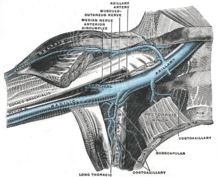Cephalic vein
The vena cephalica (German " head vein ", formerly the main vein and also the upper vein ), also called cephalica for short , is a large superficial venous blood vessel on the outside of the upper arm .
history
The term cephalica refers to "cephalon", Greek for head. However, this is a mistranslation of the Arabic term al-kífal , German "outside", in the translation of Avicenna's canon of medicine .
course
The vessel begins on the dorsal side (back of the hand) of the thumb and runs along the radial side of the forearm (V. cephalica antebrachii) to the outside of the elbow. It then runs in the outer biceps furrow (i.e. on the outside of the upper arm between the muscles that flex and stretch in the elbow joint) towards the body. Hence the name (Arabic: al kifal - outside) cephalica has nothing to do with the Greek head. See also basilic vein .
It moves in the sulcus deltoideopectoralis (at the lower edge of the delta muscle ) into a depression between the clavicle , delta muscle and large chest muscle ( Mohrenheim pit ). There it bends almost at right angles, passes through the fascia and opens into the axillary vein (armpit vein), which merges into the subclavian vein (collarbone vein ). In slim people, the vein is usually very easy to see over time.
meaning
Since the vessel is quite large, it is suitable for taking blood as well as for inserting a peripheral venous catheter . Finally, it can be used to create a shunt .
It is only suitable to a limited extent for the placement of a central venous catheter , as it makes it much more difficult to advance the catheter during placement due to the sharp bend shortly before the opening.
In order to prevent the veins from protruding both before the puncture of the vessel and e.g. B. in bodybuilding , the arm muscles are tensed. This compresses the deeper veins and allows more blood to flow through the superficial veins. A band can also be put on to constrict the vein.
Individual evidence
- ^ Bernhard D. Haage: A new text testimony to the plague poem of Hans Andree. In: Specialized prose research - Crossing borders. Volume 8/9, 2012/2013, pp. 267–282, here: p. 279.
- ^ Mohammad Diab: Lexicon of orthopedic etymology . Taylor & Francis, 1999, ISBN 978-90-5702-597-6 , p. 54.
- ↑ Rand Swenson, Etymology of shoulder and arm terms . © O'Rahilly 2008. Retrieved April 20, 2011.
- ↑ http://www.dartmouth.edu/~humananatomy/resources/etymology/Shoulder_arm.htm
swell
- Schumacher: Topographical Human Anatomy (1985)
